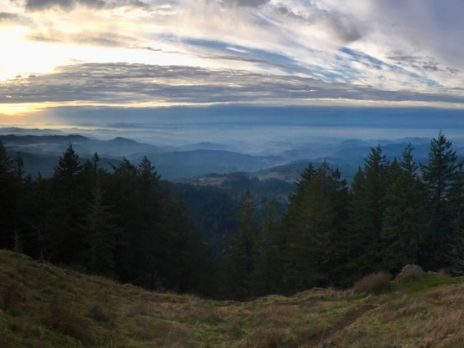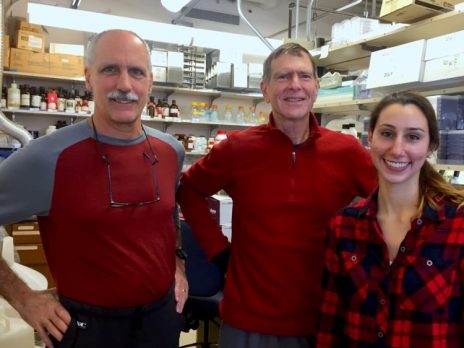I am privileged to have had the opportunity to participate in an exchange with Dr. John Postlethwait’s lab! My time spent learning new techniques, attending talks, and fighting with pipettes opened my eyes to a whole new world (Disney pun intended).

The Facts
Who? Me! Renee Jordan, PhD Student at Northern Arizona University
What? RCN g2p2pop laboratory exchange
When? December 2nd – 15th, 2018
Where? University of Oregon, Institute for Neuroscience
WHY! (1) Run RNA-seq library preps on Alaska blackfish gonad and liver samples, (2) train in bioinformatics associated with gene expression datasets, (3) advance my skill set in genetic laboratory techniques
The Project
My PhD focuses on understanding the contribution of environmental contaminants to health disparities on St. Lawrence Island, Alaska. St. Lawrence Island is located just 80km from Russia, which made it a strategic location for two military defense sites during the Cold War. Despite remediation and clean-up efforts, the formerly used defense site on the Northeast Cape of the island remains a point source for polychlorinated biphenyl (PCB) pollution and may pose a mounting health risk to local wildlife and Siberian Yupik residents living on the island. My research aims to evaluate the effects of current PCB exposure on cancer related gene expression, developmental pathologies, and genomic divergence in the ninespine stickleback (Pungitius pungitius) and Alaska blackfish (Dallia pectoralis). We hypothesize that PCB contamination from the formerly used defense site is significantly downregulating genes important in DNA repair and tumor suppression compared to fish from reference sites. The goals of this lab visit were to receive training on RNA-seq techniques and to process blackfish samples for my project.

The Exchange
Lab highlight: Getting dsDNA quantification reads after four days of RNA extractions, mRNA purification, and library prep
Eugene highlight: Hiking up Spencer’s Butte (Fig. 1, 5)
The first thing I noticed upon touching down in the Eugene, Oregon airport was the moisture. Arizona is a bit lacking in that department, and landing amid a dense fog was SO refreshing. Eugene is an interesting place to explore, with quaint coffee shops, bookstores, art museums, and hat stores. On the weekend, I took an incredible hike up Spencer’s Butte (Fig. 1, 5) south of town. The pictures don’t do it justice!
My training commenced in full force on Monday morning (after frantically trying to find the lab in the labyrinth that is Huestis Hall). Dr. Tom Titus (pictured above) and I planned out 28 blackfish samples for RNA-seq analysis and began RNA extractions. During my first week, Tom trained me in Ribopure RNA extractions, Qubit assays (RNA broad range, RNA, and dsDNA high sensitivity), Dynabeads mRNA purification, and NEXTflex Rapid Directional qRNA-seq library preparation. By Friday, we had seven beautiful RNA-seq libraries ready to go for qPCR and sequencing.

Unfortunately, Murphy’s law had other plans for the next set of samples. On Tuesday, the Qubit quantification of our RNA-seq library preps revealed that we had no dsDNA… Aka, all the samples failed. Tom and I spent the rest of the week troubleshooting and running new samples through the process (which, thankfully, are working). Despite the disappointing turn of events, it was really interesting to work through possibilities with Tom and watch how he troubleshot the issue.
During my stay, I also had the chance to meet and learn from other lab members on a variety of topics, including restriction site associated DNA sequencing, caudal fin morphology and phylogeny, and bioinformatics. I am grateful to Dr. Angel Amores, Dr. Thomas Desvignes, Jason Sydes, and Pete Batzel for dedicating hours of their time to my training.
My goals in applying for the RCN exchange were to receive training on RNA-seq techniques and to process samples for my doctoral studies. I can easily say that these goals were met and surpassed. The connections, skills, troubleshooting techniques, and experiences both in and out of the lab have enriched my understanding of molecular genetics and fostered new contacts for future work. I am very grateful to Dr. John Postlethwait for hosting me in his laboratory. Collaboration between our labs will continue to benefit my PhD work and professional network. Tom and I plan to continue our work on the blackfish samples over the next year.

I owe a huge thanks to Tom for his training and allowing me to prod his vast knowledge throughout my visit. I would also like to thank Thomas for his inclusiveness, Dr. Frank von Hippel for encouraging my application, and the RCN g2p2pop for making this trip possible!!!
And yes, plaid is a required color (: